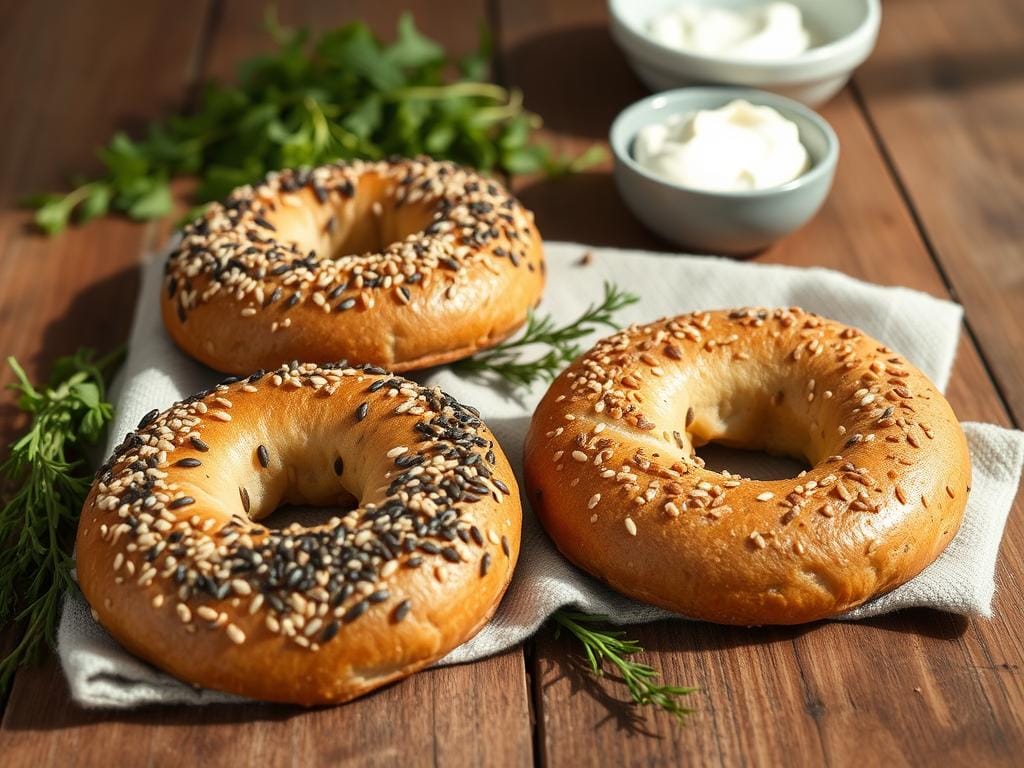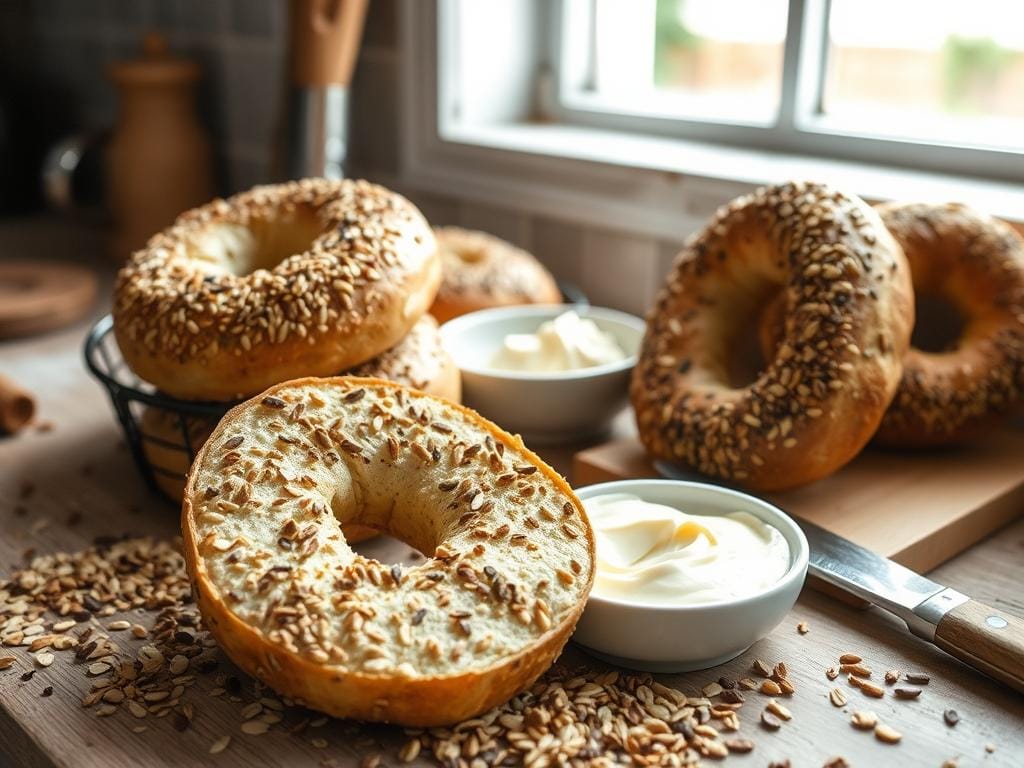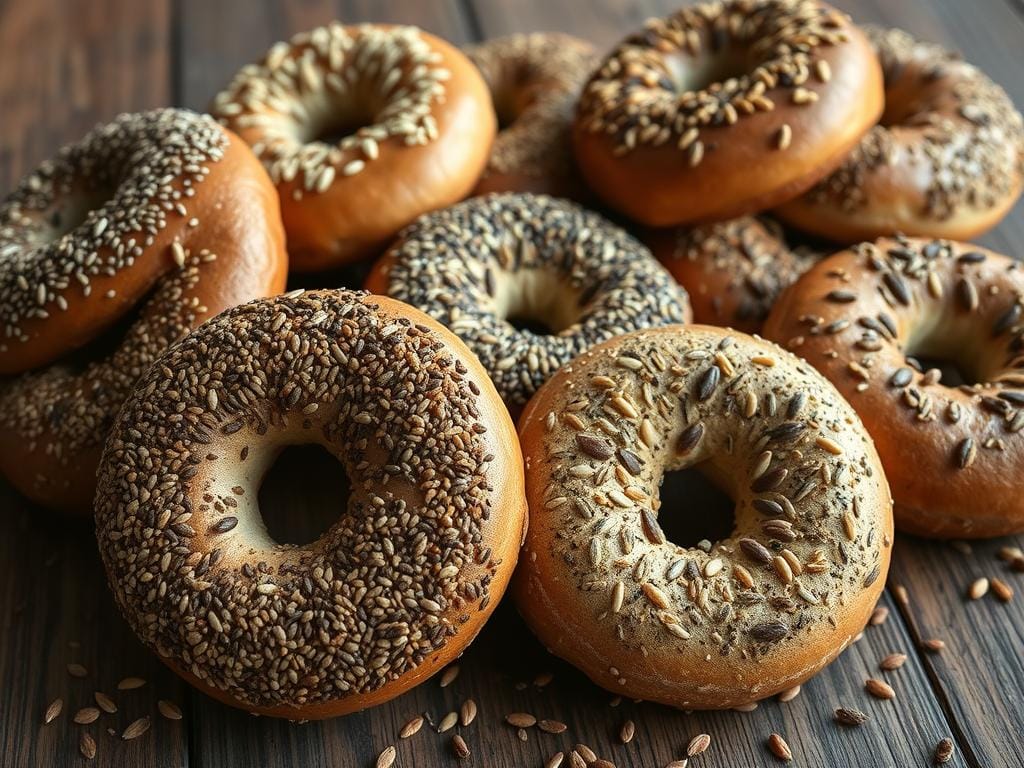As the sun peeked through my kitchen window, the aroma of freshly baked multigrain bagels filled the air. It instantly took me back to my childhood. The scent of toasted grains and the chewy texture of these bagels always brought me joy.
If you love bagels as much as I do, you’re in the right place. This guide will take you on a tasty journey through the world of multigrain bagels. We’ll explore their origins, ingredients, health benefits, and top recipes. Whether you’re health-conscious or just looking for a tasty breakfast, this guide has everything you need.
Table of contents
- Key Takeaways
- What Is a Multigrain Bagel?
- Health Benefits of Multigrain Bagels
- How to Choose the Best Multigrain Bagel
- Delicious Multigrain Bagel Recipes
- Where to Buy Multigrain Bagels
- Multigrain Bagels for Special Diets
- Storing and Freezing Multigrain Bagels
- Popular Multigrain Bagel Variations
- How to Make Multigrain Bagels at Home
- FAQ
Key Takeaways
- Multigrain bagels are a nutritious and delicious breakfast option made with a variety of whole grains.
- They provide more fiber and nutrients compared to regular bagels, making them a popular choice for health-conscious consumers.
- Multigrain bagels are known for their chewy texture and complex flavor profile, making them satisfying to eat.
- This guide covers recipes, nutrition facts, and top picks to help you navigate the world of multigrain bagels.
- Discover the health benefits of multigrain bagels, including their positive impact on heart health and overall well-being.
What Is a Multigrain Bagel?
Multigrain bagels combine whole grains like oats, rye, and seeds such as flax and sunflower. They’re a nutritious twist on the classic bagel. To explore another take on bagels, check out our article on Stuff a Bagel and discover a New York-inspired delight.
Definition and Origins
Multigrain bagels are made with various whole grains like whole wheat, oats, and rye. They also include seeds like flax, sunflower, and chia. These bagels are a healthier choice compared to regular bagels, with a denser and more artisan taste.
Common Ingredients
- Whole wheat flour
- Oats
- Flax seeds
- Sunflower seeds
- Other whole grains and seeds
The mix of whole grains and seeds makes these bagels thicker and more filling. They’re perfect for those who want a more artisan bread experience.
| Ingredient | Amount |
|---|---|
| Whole wheat flour | 4 cups |
| Bread flour | 2 cups |
| Rolled oats | 1 cup |
| Buttermilk | 1 cup |
| Wheat germ | 1/2 cup |
| Flaxseed meal | 1/4 cup |
Health Benefits of Multigrain Bagels
Multigrain bagels are packed with fiber, protein, and nutrients. Studies show that incorporating whole grains daily reduces heart disease risk by 17%. For more ideas on pairing healthy meals, explore our guide to quick and easy healthy salads for weight loss.
Nutritional Comparison with Regular Bagels
Unlike plain white-flour bagels, multigrain ones offer a better mix of nutrients. The Oldways Whole Grains Council notes that 40% of Americans never eat whole grains. Choosing multigrain bagels is a simple way to add more whole grains to your diet.
Fiber and Protein Content
A single multigrain bagel can give you up to 12 grams of protein and a big chunk of your daily fiber. Studies show that eating whole grains daily can lower heart disease risk by 17%. The fiber and protein in multigrain bagels help you feel full longer, aiding in weight control.
Heart Health and Whole Grains
The whole grains in multigrain bagels are good for your heart. They help lower cholesterol and reduce heart disease risk. The American Heart Association suggests keeping sodium intake under 2,300 mg a day. Opting for multigrain bagels is a heart-healthy choice.
How to Choose the Best Multigrain Bagel
When selecting a multigrain bagel, look for ones with whole grains as the first ingredient. Opt for options with seeds like chia or pumpkin. If you’re seeking gluten-free alternatives, read about our suggestions in the delicious leftover smoked chicken recipes, which include complementary meal ideas.
Key Ingredients to Look For
- Whole wheat flour: This flour makes the bagel dense and chewy, adding lots of fiber.
- Oats: Rolled oats or oat flour give a nutty taste and a creamy feel.
- Seeds: Bagels with sesame, sunflower, flax, and pumpkin seeds are crunchy and packed with nutrients.
Organic vs. Non-Organic Options
Opt for organic multigrain bagels if you can. Organic ones avoid synthetic pesticides and additives, making them cleaner and safer. Non-organic bagels are also good, but organic ones offer extra purity and safety.
The top multigrain bagels are dense, chewy, and full of grains and seeds. They taste rich and nutty, perfect with many toppings. Choosing whole grain options, organic or not, means you get a tasty and healthy bagel.
Delicious Multigrain Bagel Recipes
Make your breakfast better with homemade multigrain bagels. They’re great for a classic taste or new flavors. These bagels are full of nutrients and make a great start to your day.
Classic Multigrain Bagel Recipe
Make your own bagels with a mix of whole wheat, bread flour, and seeds. For a creative topping, consider nut butters or cream cheese. Add a twist by exploring our recipe for pumpkin banana muffins to pair with your bagel breakfast.
Creative Toppings for Multigrain Bagels
- Everything bagel seasoning
- Minced garlic
- Poppy seeds
- Other unique seed and spice blends
Sweet and Savory Spreads
Enhance your bagel with avocado spread or honey for a sweet touch. Learn more about topping ideas with recipes like homemade beef breakfast sausage, which pairs well with bagels for a hearty breakfast.
| Spread | Flavor Profile |
|---|---|
| Cream Cheese | Classic and creamy |
| Avocado Spread | Creamy and nutrient-dense |
| Nut Butters | Rich and protein-packed |
Where to Buy Multigrain Bagels
From national brands like Dave’s Killer Bread to local bakeries, there are plenty of choices for buying multigrain bagels. For artisanal inspirations, discover unique bread-making techniques in our feature on better bagel options.
Top National Brands
Big names like Thomas’ and Dave’s Killer Bread have lots of multigrain bagel flavors. Thomas’ has 20 types, from Whole Wheat Everything to Jalapeño Red Pepper. Dave’s Killer Bread offers 5, including Powerseed and Boomin’ Berry.
Local Bakeries Worth Trying
For a unique taste, try local artisanal bakeries. They make fresh, diverse multigrain bagels with special flavors. Lunds & Byerlys and Village Hearth are great places to start.
Multigrain Bagels for Special Diets
For those on gluten-free or vegan diets, multigrain bagels now offer great choices. Gluten-free bagels use flours like rice, sorghum, and millet. They’re a tasty, healthy option instead of wheat-based ones. Vegan bagels, without animal products, use flax eggs or aquafaba for texture and taste.
Gluten-Free Multigrain Options
People with gluten issues can enjoy multigrain bagels safely. These bagels mix gluten-free flours for a tasty, satisfying snack. Always check for the “gluten-free” label to meet your dietary needs.
Vegan Multigrain Bagel Choices
- Vegan multigrain bagels are perfect for plant-based diets, avoiding animal products like eggs and dairy.
- They use flax eggs or aquafaba for binding, just like animal products, but plant-based.
- You can find vegan multigrain bagels at health food stores, specialty bakeries, and online.
Looking for gluten-free or vegan multigrain bagels? The market has plenty of options. They’re tasty and nutritious. Check out what’s available locally or online to find your favorite.

Storing and Freezing Multigrain Bagels
Keep your bagels fresh by storing them in airtight containers. Freeze them for up to three months, and reheat them directly from frozen for a perfect texture. Learn more about reheating methods by exploring easy slow-cooker recipes.
Best Practices for Freshness
For a short time, store your bagels in an airtight container at room temperature. This keeps them fresh for up to 2 days. Don’t refrigerate them, as cold air can make them stale quicker.
Thawing and Reheating Tips
For longer storage, the freezer is your ally. Wrap them in plastic bags or airtight containers and freeze for up to 3 months. To thaw, let them sit at room temperature or toast them from frozen. Toasting from frozen helps keep them crispy and soft.
Freezing them sliced is best. It makes toasting or reheating easier. With the right storage and freezing methods, you can enjoy fresh bagels anytime, keeping their freshness intact.
Popular Multigrain Bagel Variations
There are many tasty variations of multigrain bagels. You can try an everything bagel for a mix of flavors. Or, go for the crunch of sesame and poppy seed toppings. These options let you enjoy the health benefits of multigrain bagels in new ways.
Everything Multigrain Bagels
Combine the best flavors with garlic, sesame, and poppy seeds on a multigrain base. To mix things up, try pairing with unique dishes like Asian-inspired stir-fry noodles.
Sesame and Poppy Seed Variations
Classic yet flavorful, these bagels are perfect with savory toppings. Explore our dense bean salad recipes to complement the rich flavors of sesame and poppy seeds.
| Bagel Variation | Flavor Profile | Texture |
|---|---|---|
| Everything Multigrain | Savory blend of garlic, onion, sesame, and poppy | Crisp, crunchy exterior with a chewy interior |
| Sesame Multigrain | Nutty, toasted sesame flavor | Crunchy, textured topping with a soft bagel base |
| Poppy Seed Multigrain | Subtle, earthy poppy seed flavor | Dotted with crunchy poppy seeds throughout |
These multigrain bagel variations are a fun way to get more nutrients. Whether you like the mix of flavors in an everything bagel or the classic taste of sesame and poppy seed, there’s a bagel for everyone.
How to Make Multigrain Bagels at Home
Enjoy the smell of freshly baked multigrain bagels in your kitchen. This recipe is easy to follow. You can control the ingredients and flavors, making it a nutritious breakfast or snack. Let’s start making your own baking masterpiece.
Essential Tools and Equipment
You’ll need a few basic tools:
- Large mixing bowl
- Wooden spoon or dough hook for your stand mixer
- Baking sheet or pizza stone
- Large pot for boiling the bagels
- Parchment paper or silicone baking mat
Step-by-Step Guide
Follow these simple steps to create delicious multigrain bagels in your own kitchen:
- Mix the dough: In a large bowl, combine bread flour, instant yeast, sugar, and salt. Add warm water and Greek yogurt, then knead the dough for about 10 minutes until smooth and elastic.
- Let it rise: Cover the dough and let it proof for 1 hour at room temperature until it doubles in size.
- Shape the bagels: Divide the dough into 6 equal pieces, each weighing approximately 92 grams. Roll each piece into a ball, then use your finger to poke a hole in the center and gently stretch the dough to form a bagel shape.
- Boil the bagels: Bring a large pot of water to a boil. Carefully add the shaped bagels and boil for 2 minutes on each side to create the chewy crust.
- Bake to perfection: Transfer the boiled bagels to a baking sheet lined with parchment paper or a silicone baking mat. Bake at 425°F for about 20 minutes, or until golden brown.
With this simple recipe, you can enjoy fresh, nutritious, and customizable bagels right from your own kitchen. Experiment with different toppings and flavors to make each batch unique.

FAQ
1. Is a multigrain bagel healthy?
It can be a healthier option than traditional plain bagels, as they typically contain a variety of grains, such as oats, barley, millet, and whole wheat, which provide more fiber, vitamins, and minerals. However, they can still be high in carbohydrates and calories, so it’s important to consume them in moderation, especially if you’re watching your caloric intake or blood sugar levels.
2. What is a multigrain bagel?
It is a type of bagel made from a blend of different grains, such as whole wheat, oats, barley, flaxseeds, or millet. These grains provide a variety of nutrients, including fiber, protein, and essential fatty acids, which are generally more nutritious than a bagel made from refined white flour. Multigrain bagels are typically denser and heartier than their plain counterparts.
3. Is Dunkin’ Donuts multigrain bagel good for you?
Dunkin’ Donuts’ multigrain bagel can be a better choice compared to their plain bagels, as it contains a mix of whole grains and seeds, offering more fiber and nutrients. However, it may still be processed and contain added sugars or preservatives, so it’s not necessarily a “health food.” To make it healthier, you could skip any sugary spreads or toppings and pair it with a protein source, like eggs or nut butter.
4. What are the healthiest bagels to eat?
The healthiest bagels are generally those that are made from whole grains or those that contain added seeds, nuts, or oats, which contribute more fiber and nutrients. Some good options include:
- Whole wheat bagels: Made from 100% whole wheat flour, offering more fiber than regular white flour bagels.
- Sprouted grain bagels: Made with sprouted grains, which can be easier to digest and have higher nutrient content.
- Oatmeal bagels: Contain oats, which are rich in fiber and heart-healthy.
- Seeded bagels: Bagels with flaxseeds, chia seeds, or sunflower seeds, which add healthy fats and fiber.
When choosing a bagel, opt for ones with fewer added sugars and preservatives, and consider pairing them with healthy toppings like avocado, hummus, or lean proteins.

